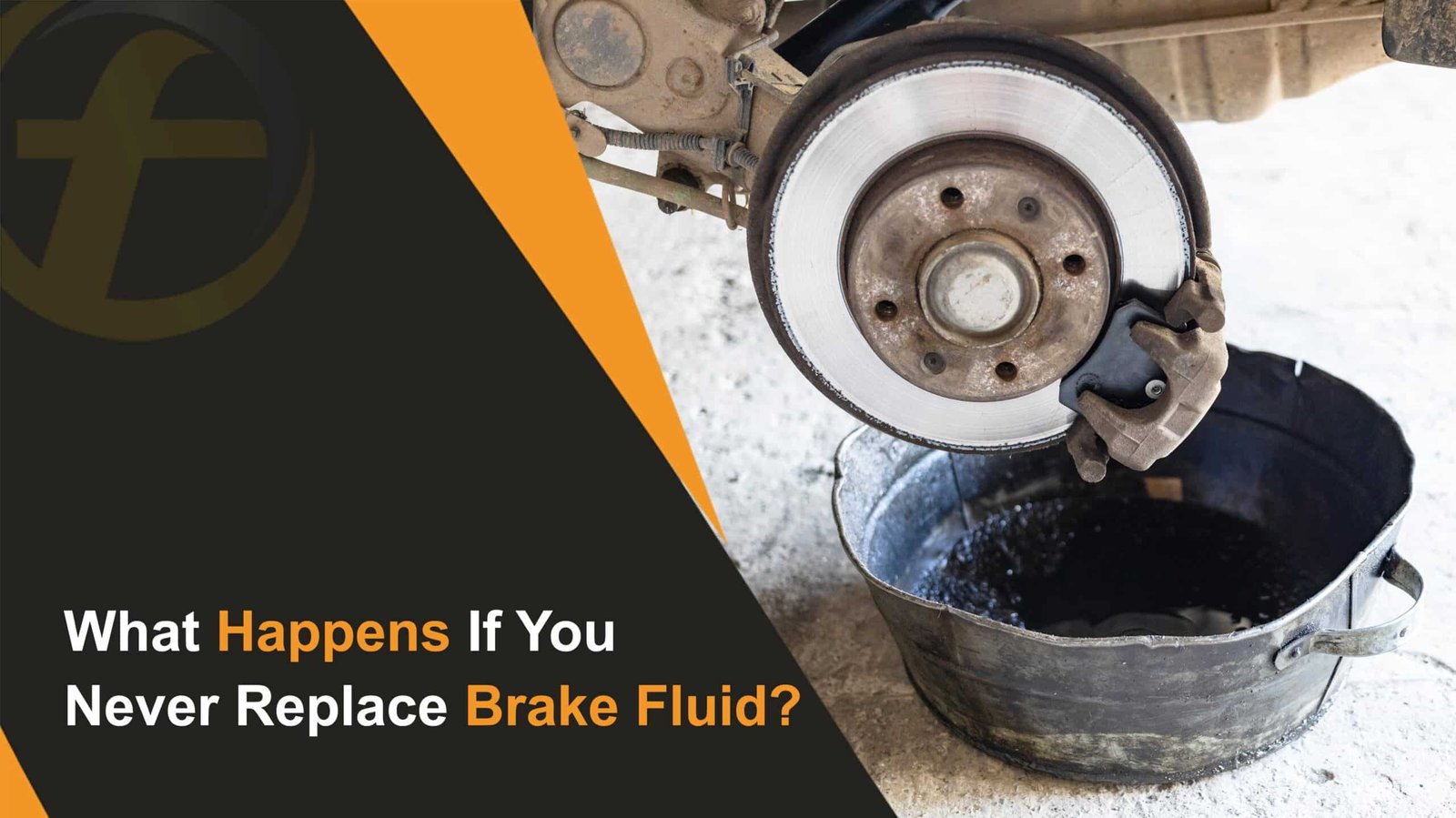
Brakes are one of the most important safety systems in your car, and they can’t work properly without brake fluid. Many drivers don’t realize how much this fluid matters until problems appear. At Fubex Lubricants, we offer high-quality brake fluid for all types of engines. Enjoy fast shipping, a price match guarantee, and no-questions-asked returns. Need help choosing the right oil? Call us at +971 50 544 9614 — our friendly team is ready to assist!
So, what happens if you never replace brake fluid? The truth is, old or dirty fluid can weaken your braking power, damage parts, and even put your safety at risk.
What is Brake Fluid?
Your car’s brake system has three main parts: the rotor, caliper, and brake pads. When you press the brake pedal, the caliper squeezes the pads against the rotor (the disc connected to the wheel). This slows the car down.
But this can’t happen without brake fluid. Brakes work through a hydraulic system, which means they use liquid to create pressure. When you press the pedal, the brake fluid takes that force and sends it to the front and back brakes. This is how your car slows down or stops.
Brake fluids are grouped by the Department of Transportation (DOT). The main types are DOT 3, DOT 4 (both glycol-based), and DOT 5 (silicone-based). DOT 3 and DOT 4 absorb water, while DOT 5 does not.
Over time, brake fluid heats up. If it gets too hot and boils, it turns into gas. Gas can’t transfer pressure like liquid, which may cause weak brakes or even total brake failure. That’s why it’s important to replace brake fluid regularly to keep your brakes working safely.
How Often Should You Change Brake Fluid?
Most experts recommend changing brake fluid every 2 years or about 20,000 miles. But the exact time can depend on how you drive. If you brake hard or drive in tough conditions, you may need to change it more often. The age of your car, how much you drive, and where you drive also make a difference.
The safest way to know if your brake fluid is still good is to have a mechanic check it. There are some do-it-yourself tests, but they aren’t very accurate.
Remember, changing brake fluid isn’t optional—it’s important. Ignoring it can cause serious problems.
What Happens If You Don’t Change It?
Brake fluid absorbs water over time. The more water it holds, the lower its boiling point becomes. When the fluid gets too hot, it can boil and turn into gas. Gas can’t transfer pressure like liquid, which makes your brakes weak or unsafe.
Moisture inside the brake system can also cause rust and damage to key parts like the master cylinder, calipers, and brake lines. Fixing or replacing these parts can be very expensive, while changing the brake fluid is simple and usually costs much less.
Why Do You Need To Change Brake Fluid?
Brake fluid pulls in water from the air. When this happens, the fluid gets weaker and its boiling point drops. Since brakes create a lot of heat, the fluid must stay strong to handle it. If it overheats, it can turn into vapor and cause problems.
Water inside the system can also lead to rust and damage. Over time, heat and moisture make the fluid less safe. That’s why it’s recommended to flush out the old brake fluid every 2–3 years and replace it with fresh, high-quality brake fluid to keep your brakes working their best.
What Happens If You Never Change Brake Fluid?
If brake fluid is never replaced, it collects moisture over time. This makes the fluid weaker and lowers its boiling point. The water inside can also cause rust and damage in the brake lines, which may even lead to failure. When brakes are used a lot and get very hot, old fluid can boil and turn into vapor.
This creates a problem called brake fade, where the brakes lose stopping power and may not work when you need them most.
How Long Can You Go Without Changing Brake Fluid?
Brake fluid usually lasts about 2–3 years in most cars. To stay safe, it’s best to replace it every 2 years. If you get your car serviced once a year (which is recommended), your mechanic can check the brake system and tell you if the fluid is still good.
Now that you know why brake fluid is important and why it needs to be replaced, let’s look at the signs that tell you it’s time for a flush — and how the process is done.
8 Signs of Old Brake Fluid You Shouldn’t Ignore
Watching out for these signs helps keep your brakes strong and keeps you safe on the road.
- Brake Warning Light – Many cars have a dashboard light that turns on if there’s a problem with the brake system, including low or weak brake fluid.
- Soft or Spongy Pedal – If your brake pedal feels soft or sinks closer to the floor before working, it could mean air or old fluid in the system.
- Hard Brake Pedal – If the pedal feels unusually stiff, it may be caused by a blockage or dirty fluid.
- Strange Noises – Grinding, squealing, or screeching sounds when braking can point to worn parts or brake fluid issues.
- Leaking Fluid – Fluid under the car or near the wheels may mean a leak, which lowers your brake fluid level.
- Weak Braking Power – If it takes longer for your car to stop or the brakes don’t feel sharp, old fluid could be the reason.
- Dirty Fluid – Brake fluid should look clear or slightly yellow. If it looks dark, dirty, or cloudy, it needs to be replaced.
- Car Pulls to One Side – If your car drifts left or right while braking, uneven fluid or other brake issues may be to blame.
If you notice any of these symptoms, it’s recommended to have your brake system checked and the fluid changed to keep your car safe.
How to Change Brake Fluid
It’s always best to let a professional do this job, but you can change brake fluid yourself if you know what you’re doing. The steps can be a little different depending on your car, but here are the basics. If you’re not sure about your brake system or don’t feel confident, it’s recommended to have a qualified mechanic do it for you.
Tip: It’s easier to see and work on the brakes if you take off the wheels. This means you’ll need to safely jack up the car and remove each tire the right way.
What You’ll Need:
- Fresh brake fluid (check your car’s manual for the right type and amount)
- A wrench that fits your car’s bleeder valves
- A brake bleeder kit or a clear tube with a collection bottle
- A friend to help
- Safety gloves and glasses
- A clean rag
How to Flush and Replace Brake Fluid
1. Get Your Car Ready
- Park on a flat surface.
- Put the car in “Park” (automatic) or in gear (manual).
- Use the parking brake.
- Open the hood and find the brake fluid reservoir on the master cylinder.
- Clean around the cap so no dirt gets inside.
2. Check the Fluid
- Look at the color and level of the brake fluid. If it’s dark or dirty, it needs changing.
- Wipe around the reservoir and cap with a clean rag.
3. Drain the Old Fluid
- Start with the brake that’s farthest from the master cylinder (usually back passenger side). Then do the back driver’s side, front passenger side, and last the front driver’s side.
- Attach a clear tube from the bleeder kit to the brake caliper valve. Put the other end into a bottle with a little brake fluid in it (to stop air from going back).
- Loosen the bleeder valve with a wrench.
- Have a friend press the brake pedal slowly and hold it down. Fluid and air will come out into the bottle.
- Tighten the valve before your friend releases the brake pedal.
4. Flush with New Fluid
- Add fresh brake fluid into the reservoir.
- Keep bleeding each brake until clean fluid comes out with no air bubbles.
- Always check the reservoir so it never runs dry.
5. Final Checks
- Fill the reservoir to the “MAX” line when finished.
- Test the brake pedal while the car is off. It should feel firm, not soft. If it feels spongy, repeat the bleeding.
- Get rid of old brake fluid safely—it’s hazardous waste.
6. Safety Check
- Clear tools and bottles from your work area.
- Start your car and test the brakes slowly in a safe spot to make sure they work properly.
Safety Tips
- Always wear gloves and safety glasses.
- Work in fresh air so you don’t breathe in fumes.
- Never reuse old fluid. Always use the type of brake fluid recommended for your car.
Also Read: Which Brake Fluid is Best for My Car: DOT 3, DOT 4, or DOT 5?
Low Brake Fluid and When to Change It
There are some clear signs that your brake fluid may need to be topped up or replaced. Watch out for these:
- The brake or ABS warning light comes on, meaning there’s an issue with the system.
- ABS starts working in situations where it normally wouldn’t.
- You need to press the brake pedal harder, or it feels soft and spongy.
- You notice vibrations or squealing sounds when braking.
- A burning smell appears after hard braking.
Even if you don’t notice these signs, it’s smart to check the fluid yourself. Open the brake fluid reservoir on top of the master cylinder. Fresh fluid should look clear with a slight orange, blue, or green tint. If it looks dark or dirty, it’s time to change it.
Also Read: What’s the Difference Between Brake Fluid and Hydraulic Fluid?
Final Takeaways
Your brake system depends on clean, fresh fluid to work safely. What happens if you never replace brake fluid? Over time, moisture and heat will break it down, lowering its boiling point and risking brake fade, rust, or even total failure. Replacing brake fluid on schedule is a simple, low-cost step that protects your car and keeps you safe on the road.
FAQs
Q1: What does brake fluid do for a car?
Brake fluid powers the hydraulic system, helping your car stop when you press the pedal. If it’s low, dirty, or not flowing well, your braking power weakens.
Q2: What happens to brake fluid over time?
Brake fluid absorbs moisture as it ages, which can cause rust and lower braking performance. This makes stopping less safe in critical moments.
Q3: How do you check it?
Most cars have a clear reservoir so you can see the fluid level without opening the cap. Since air can add moisture, it’s safer to let a mechanic handle it.
Q4: How often do you need to change it?
Change times depend on your car and driving, but a safe rule is every 4–5 years. Check it at oil changes or sooner if it smells burnt, looks dark, or is low.

Editor-at-Large
A passionate writer in the lubricant industry, Awais Iqbal has been covering oils, greases, and industrial fluids since the start of his career. At 25, he’s already written for blogs, catalogs, and brand guides across the UAE. Awais’s insights help companies connect with their audience, and his clear, helpful writing style is trusted by brands in the region.


